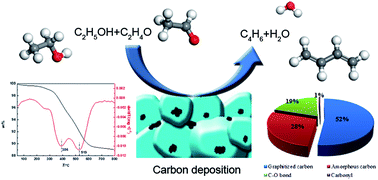The deactivation of a ZnO doped ZrO2–SiO2 catalyst in the conversion of ethanol/acetaldehyde to 1,3-butadiene†
Abstract
A deactivation study on the ethanol/acetaldehyde conversion to 1,3-butadiene over a ZnO promoted ZrO2–SiO2 catalyst prepared by a sol–gel method was performed. The samples were characterized by N2 adsorption–desorption isotherms, scanning electron microscopy (SEM), NH3 temperature programmed desorption (NH3-TPD), X-ray powder diffraction characterization (XRD), thermogravimetric analyses (TGA), Fourier transform infrared resonance (FT-IR), 13C magic-angle spinning nuclear magnetic resonance (13C NMR) and X-ray photoelectron spectroscopy (XPS). The pore structure characteristics and surface acidity of Zn0.5–Zr–Si catalysts were largely decreased with time-on-stream and no crystal structure was formed in the used catalyst, indicating that the deactivation was caused by carbon deposition. Two main types of carbon deposition were formed, namely low-temperature carbon deposition with the oxidation temperature of around 400 °C and high-temperature carbon deposition with the oxidation temperature of 526 °C. The carbon species were mainly composed of graphitized carbon, amorphous carbon, carbon in C–O bonds and carbonyls. The deactivated catalyst could be regenerated by a simple oxidation process in air. Adding a certain amount of water into the feed had a positive effect on reducing the carbon deposition.



 Please wait while we load your content...
Please wait while we load your content...